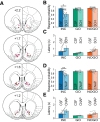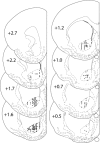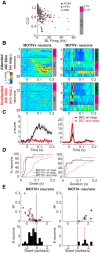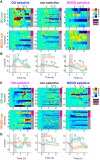The Nucleus Accumbens Core Is Necessary for Responding to Incentive But Not Instructive Stimuli
- PMID: 31862857
- PMCID: PMC7002156
- DOI: 10.1523/JNEUROSCI.0194-19.2019
The Nucleus Accumbens Core Is Necessary for Responding to Incentive But Not Instructive Stimuli
Abstract
An abundant literature has highlighted the importance of the nucleus accumbens core (NAcC) in behavioral tasks dependent on external stimuli. Yet, some studies have also reported the absence of involvement of the NAcC in stimuli processing. We aimed at comparing, in male rats, the underlying neuronal determinants of incentive and instructive stimuli in the same task. We developed a variant of a GO/NOGO task that reveals important differences in these two types of stimuli. The incentive stimulus invites the rat to engage in the task sequence. Once the rat has decided to initiate a trial, it remains engaged in the task until the end of the trial. This task revealed the differential contribution of the NAcC to responding to different types of stimuli: responding to the incentive stimulus depended on NAcC AMPA/NMDA and dopamine D1 receptors, but the retrieval of the response associated with the instructive stimuli (lever pressing on GO, withholding on NOGO) did not. Our electrophysiological study showed that more NAcC neurons responded more strongly to the incentive than the instructive stimuli. Furthermore, when animals did not respond to the incentive stimulus, the induced excitation was suppressed for most projection neurons, whereas interneurons were strongly activated at a latency preceding that found in projection neurons. This work provides insight on the underlying neuronal processes explaining the preferential implication of the NAcC in deciding whether and when to engage in reward-seeking rather than to decide which action to perform.SIGNIFICANCE STATEMENT The nucleus accumbens core (NAcC) is essential to process information carried by reward-predicting stimuli. Yet, stimuli have distinct properties: incentive stimuli orient the attention toward reward-seeking, whereas instructive stimuli inform about the action to perform. Our study shows that, in male rats, NAcC perturbation with glutamate or dopamine antagonists impeded responses to the incentive but not to the instructive stimulus. NAcC neuronal recordings revealed a stronger representation of incentive than instructive stimuli. Furthermore, we found that interneurons are recruited when rats fail to respond to incentive stimuli. This work provides insight on the underlying neuronal processes explaining the preferential implication of the NAcC in deciding whether and when to engage in reward-seeking rather than to decide which action to perform.
Keywords: dopamine; electrophysiology; interneurons; motivation; nucleus accumbens core; stimuli.
Copyright © 2020 the authors.
Figures






Similar articles
-
The role of nucleus accumbens dopamine in motivated behavior: a unifying interpretation with special reference to reward-seeking.Brain Res Brain Res Rev. 1999 Dec;31(1):6-41. doi: 10.1016/s0165-0173(99)00023-5. Brain Res Brain Res Rev. 1999. PMID: 10611493 Review.
-
Orexin in the Posterior Paraventricular Thalamus Mediates Hunger-Related Signals in the Nucleus Accumbens Core.Curr Biol. 2019 Oct 7;29(19):3298-3306.e4. doi: 10.1016/j.cub.2019.07.069. Epub 2019 Sep 19. Curr Biol. 2019. PMID: 31543448
-
Phasic Dopamine Transmission Reflects Initiation Vigor and Exerted Effort in an Action- and Region-Specific Manner.J Neurosci. 2016 Feb 17;36(7):2202-11. doi: 10.1523/JNEUROSCI.1279-15.2016. J Neurosci. 2016. PMID: 26888930 Free PMC article.
-
Differential Dopamine Release Dynamics in the Nucleus Accumbens Core and Shell Reveal Complementary Signals for Error Prediction and Incentive Motivation.J Neurosci. 2015 Aug 19;35(33):11572-82. doi: 10.1523/JNEUROSCI.2344-15.2015. J Neurosci. 2015. PMID: 26290234 Free PMC article.
-
Motivational views of reinforcement: implications for understanding the behavioral functions of nucleus accumbens dopamine.Behav Brain Res. 2002 Dec 2;137(1-2):3-25. doi: 10.1016/s0166-4328(02)00282-6. Behav Brain Res. 2002. PMID: 12445713 Review.
Cited by
-
Quantifying the instrumental and noninstrumental underpinnings of Pavlovian responding with the Price equation.Psychon Bull Rev. 2022 Aug;29(4):1295-1306. doi: 10.3758/s13423-021-02047-z. Epub 2021 Dec 16. Psychon Bull Rev. 2022. PMID: 34918283 Review.
-
Cortical-striatal brain network distinguishes deepfake from real speaker identity.Commun Biol. 2024 Jun 11;7(1):711. doi: 10.1038/s42003-024-06372-6. Commun Biol. 2024. PMID: 38862808 Free PMC article.
-
Environmental enrichment enhances ethanol preference over social reward in male swiss mice: Involvement of oxytocin-dopamine interactions.Neuropharmacology. 2024 Aug 1;253:109971. doi: 10.1016/j.neuropharm.2024.109971. Epub 2024 May 4. Neuropharmacology. 2024. PMID: 38705568 Free PMC article.
-
Threat and Bidirectional Valence Signaling in the Nucleus Accumbens Core.J Neurosci. 2022 Feb 2;42(5):817-833. doi: 10.1523/JNEUROSCI.1107-21.2021. Epub 2021 Nov 11. J Neurosci. 2022. PMID: 34764160 Free PMC article.
-
Distinct Action Signals by Subregions in the Nucleus Accumbens during STOP-Change Performance.J Neurosci. 2024 Jul 17;44(29):e0020242024. doi: 10.1523/JNEUROSCI.0020-24.2024. J Neurosci. 2024. PMID: 38897724 Free PMC article.
References
Publication types
MeSH terms
LinkOut - more resources
Full Text Sources
